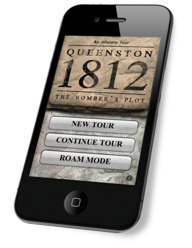Where are they now? An Update from Eric G. Poitras.
19 November 2015 - 8:23am
Eric G. Poitras, Assistant Professor of Instructional Design and Educational Technology at the University of Utah

The research led by members of the Advanced Instructional Systems and Technologies (ASSIST) laboratory in augmented reality aims to examine the impact of mobile and wearable devices towards learning and engagement in the context of guided walking tours. Museum exhibits and cultural heritage sites offer a wealth of information useful to teachers in PreK-12 classrooms, but the educational potential of these resources is often limited to schools located in the immediate surrounding area. Recent advances in online virtual displays (e.g., Google Earth and Microsoft Photosynth) breaks down traditional barriers to instruction, enabling students to experience these distant locations on the web.
At the same time, our team relies on these interactive displays to simulate guided walking tours in a laboratory setting. Research with augmented reality devices that track the location of visitors to deliver multimedia content is traditionally conducted in the field, where visitors walk through actual tour locations. The re-creation of this authentic experience in the laboratory allows us to manipulate specific aspects of the tour experience to gain better understanding of their role in learning and instruction under controlled conditions. We capture learning and engagement by collecting converging evidence from multiple measures and sensors, including self-reports and task performance outcomes, physiological and biomechanical recordings, logged behavioral observations, as well as eye-gaze tracking and facial expression recognition.
 In collaboration with Drs. Jason Harley (University of Alberta), Susanne Lajoie (McGill University), and Kevin Kee (University of Ottawa) and with the support of the Learning Environments Across Disciplines research partnership of the Social Sciences and Humanities Research Council of Canada, we have examined several tours augmented through smart phone applications, and most recently using Google Glass devices (e.g., Queenston 1812, MTL Urban Museum, Discover the U). The findings obtained from these empirical studies establish best practices in the design of augmented reality applications for guided walking tours, while also allowing us to gain better understanding of the tour guide and visitor dynamics that result in meaningful learning experiences.
In collaboration with Drs. Jason Harley (University of Alberta), Susanne Lajoie (McGill University), and Kevin Kee (University of Ottawa) and with the support of the Learning Environments Across Disciplines research partnership of the Social Sciences and Humanities Research Council of Canada, we have examined several tours augmented through smart phone applications, and most recently using Google Glass devices (e.g., Queenston 1812, MTL Urban Museum, Discover the U). The findings obtained from these empirical studies establish best practices in the design of augmented reality applications for guided walking tours, while also allowing us to gain better understanding of the tour guide and visitor dynamics that result in meaningful learning experiences.
For research purposes, we have also developed the mObserver application, an intelligent quantitative field observation system that allows researchers to study discourse processes and log behavioral observations in real-time. These observations are recorded and analyzed by the system, which then adapts the delivery of content to the experimenters, allowing them to shadow discourse moves while playing the role of tour guides. We study effective discourse in guided walking tours as a means to design a virtual tour guide that is capable of simulating dialogue moves and that would complement existing tours augmented through mobile and wearable devices.

